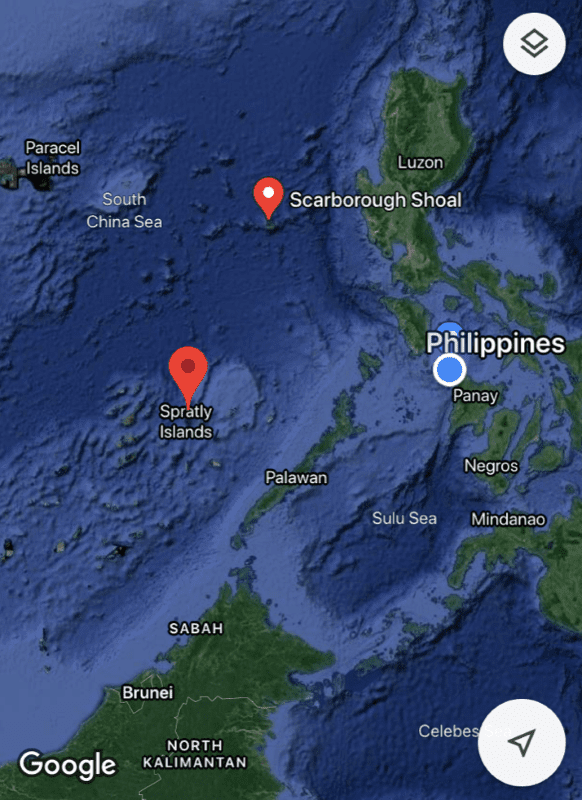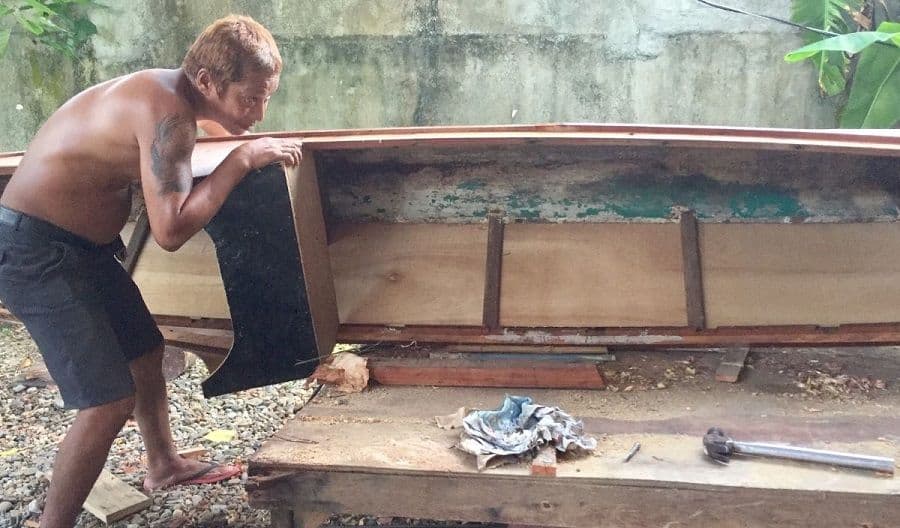Last Updated on May 28, 2023 by Ellen
A boat motor broke the predawn silence today. Still dark, I looked to the water to find the fishing boat. I hoped the fishermen had great luck, and were coming back with a large catch to eat and to sell.
Fish is a paramount source of protein in the Philippines – an island nation. You see people selling fresh fish on street corners, at roadside stands, in the wet markets. You also see small fish drying on tables virtually anywhere in the sun. Once dry, the fish are bagged and sold.
We had fresh fish tonight at dinner, as we do many nights. A fresh tuna filet, $2.80, enough for the three of us: me, Tedly, and mom Diane. Like our Filipino friends, we eat a lot of fish.
Building a boat
With no tourists staying at the Hangout Beach Resort because of COVID-19, the owner and her friends are building a fishing boat. Anything they catch from the sea is free for them to eat, and to sell.
The boat builder is our friend Bong Bong. He’s got a great sense of humor, and he’s one hell of a carpenter.
Bong Bong learned to build boats from his father on Boracay Island. I have heard him working on the boat for long hours, in the heat, over many, many days.

He hopes to have the boat ready in about one more week. Today, a good mechanic — another friend at the Hangout — got a used engine for the boat running and humming.
The boat will be painted a lighter blue, and the name will be the Hangout Express.
A local friend told me large fish used to be found a few feet off shore here on northern Panay Island about a decade ago. Now, you need a boat with a motor and some know-how to catch anything big. The people who can’t afford a motor boat fish with shore nets or spears.
I hope there are loads of fish taken in by the Hangout Express – and for all Filipino fishermen.
Local hunger
Hunger is now an issue for some people in this region, especially on Boracay Island, where white-collar Filipinos are not fishermen. With no tourism, there’s no income.
“We are 62,000 workers, we are facing hunger.”
Boracay official
Recently, one Boracay lawmaker proposed food stamps, and cited how it works in the United State of America. Another is quoted as saying, “…we are 62,000 workers, we are facing hunger.”
A columnist for the Philippine Star recently wrote how China steals a minimum of 1.2 billion tons of fish from Filipinos each year. China’s activities in this region are in the news here. It’s a safe bet the majority American public knows nothing of the South China Sea tensions.
National fish fights with China
Southeast Asian countries lay claim to islands and atolls in the South China Sea. So does China, notorious for overfishing closer to its borders.
The South China Sea has immense amounts of fish, and suspected oil and gas deposits. A major international shipping lane runs through this region.
Over the last several years, China has essentially claimed nearly all of the South China Sea for itself — hundreds and hundreds of miles from China’s nearest island.
China has constructed military bases on islands it has built from sand bars. These bases have anti-aircraft missile launchers, runways, ports and more. It’s all been done around a new (invisible) Great Wall from China — the so-called “nine-dash line.” The line extends hundreds of miles to claim about 90 percent of the disputed waters.
In the map below, note the Spratly Islands and the Scarborough Shoal. These are two disputed areas closest to the Philippines. (Earth Vagabonds are the blue dot.)

In 2013, the Philippines brought an arbitration case to The Hague to contest the legality of the nine-dash line. In 2016, the court ruled China doesn’t have the right to claim the huge territory and its resources.
China ignored the court decision, and has since continued to militarize its man-made islands, and continued to fish.
Philippine response
A year ago, Philippine President Rodrigo Duterte is quoted as saying, ““When Xi says I will fish, who can prevent him?” He was referring to Chinese President Xi Jinping.
Duterte’s response to China’s territorial aggression has so far been weighed against Chinese investment and spending in the Philippines. For example, Chinese tourists made up half the crowds at famous beach destinations like Boracay before the pandemic.
Muted tolerance from Manila was reinforced this week. Philippine and Chinese diplomats held a virtual meeting. The outcome: the countries will handle the South China Sea dispute “through ‘friendly’ consultations.”
Yet local governments in the Western Visaya region are stepping up their territorial claims against Chinese occupation.
Duterte will give his state of the nation address on July 27. We’ll have to wait and see if the national stance changes.
American response
A U.S. Navy destroyer challenged China this week with a ship run near the contested Spratly Islands. The government released a few photos.

It was nicknamed a ‘freedom’ run, and it happened after the U.S. State Department formally rejected China’s territorial claims in the South China Sea.
Is it just a show? A sincere threat? Hard to tell from an ego maniac desperate to win the presidential re-election.
Donald Trump is ramping up the rage against China’s maritime claims, the Hong Kong issue, and, of course, the pandemic – which started in China.
Back to the Hangout Express
There is no immediate concern in our immediate area about Chinese fishing and occupation. The waters near us are clearly Philippine territory.
People in our area of Malay, Aklan, on Panay Island, are gearing up for the long haul without tourism income. They’re doing things like building boats, planting gardens, selling items they cook.
The Filipinos I have come to know — like our friend Bong Bong — are resourceful, hard working people who are going to survive this thing with dignity intact.
I can’t wait to buy fish from Bong Bong’s catches on the Hangout Express.

Thanks for reading, “Building a boat; fish fights with China.”
What to read next:

